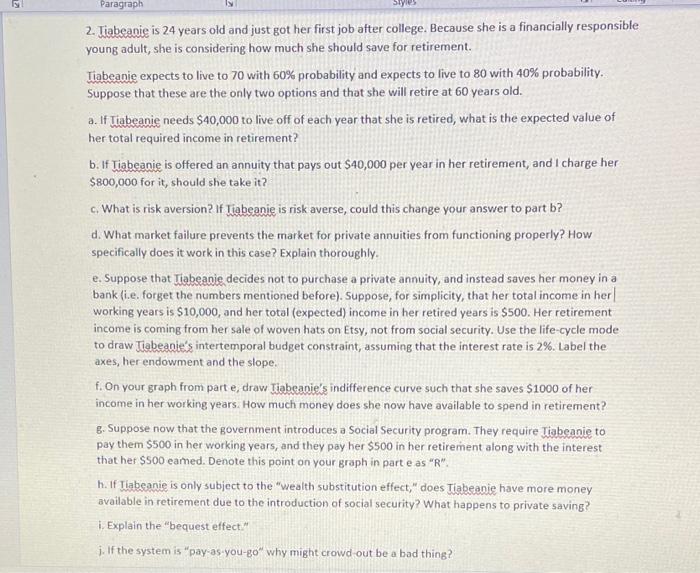Paragraph Styles 2. Tiabeanie is 24 years old and just got her first job after college. Because she is a financially responsible young adult, she is considering how much she should save for retirement. Tiabeanie expects to live to 70 with 60% probability and expects to live to 80 with 40% probability. Suppose that these are the only two options and that she will retire at 60 years old. a. If Tiabeanie needs $40,000 to live off of each year that she is retired, what is the expected value of her total required income in retirement? b. If Tiabeanie is offered an annuity that pays out $40,000 per year in her retirement, and I charge her $800,000 for it, should she take it? c. What is risk aversion? If Tiabeanie is risk averse, could this change your answer to part b? d. What market failure prevents the market for private annuities from functioning properly? How specifically does it work in this case? Explain thoroughly. e. Suppose that Tiabeanie decides not to purchase a private annuity, and instead saves her money in a bank (i.e. forget the numbers mentioned before). Suppose, for simplicity, that her total income in her working years is $10,000, and her total (expected) income in her retired years is $500. Her retirement income is coming from her sale of woven hats on Etsy, not from social security. Use the life-cycle mode to draw Tiabeanie's intertemporal budget constraint, assuming that the interest rate is 2%. Label the axes, her endowment and the slope. f. On your graph from parte, draw Tiabeanie's indifference curve such that she saves $1000 of her income in her working years. How much money does she now have available to spend in retirement? 5. Suppose now that the government introduces a Social Security program. They require Tiabeanie to pay them $500 in her working years, and they pay her $500 in her retirement along with the interest that her $500 eamed. Denote this point on your graph in parte as "R". h. If Tiabeanie is only subject to the "wealth substitution effect," does Tiabeanie have more money available in retirement due to the introduction of social security? What happens to private saving? 1. Explain the "bequest effect." j. If the system is "pay-as-you-go" why might crowd out be a bad thing? Paragraph Styles 2. Tiabeanie is 24 years old and just got her first job after college. Because she is a financially responsible young adult, she is considering how much she should save for retirement. Tiabeanie expects to live to 70 with 60% probability and expects to live to 80 with 40% probability. Suppose that these are the only two options and that she will retire at 60 years old. a. If Tiabeanie needs $40,000 to live off of each year that she is retired, what is the expected value of her total required income in retirement? b. If Tiabeanie is offered an annuity that pays out $40,000 per year in her retirement, and I charge her $800,000 for it, should she take it? c. What is risk aversion? If Tiabeanie is risk averse, could this change your answer to part b? d. What market failure prevents the market for private annuities from functioning properly? How specifically does it work in this case? Explain thoroughly. e. Suppose that Tiabeanie decides not to purchase a private annuity, and instead saves her money in a bank (i.e. forget the numbers mentioned before). Suppose, for simplicity, that her total income in her working years is $10,000, and her total (expected) income in her retired years is $500. Her retirement income is coming from her sale of woven hats on Etsy, not from social security. Use the life-cycle mode to draw Tiabeanie's intertemporal budget constraint, assuming that the interest rate is 2%. Label the axes, her endowment and the slope. f. On your graph from parte, draw Tiabeanie's indifference curve such that she saves $1000 of her income in her working years. How much money does she now have available to spend in retirement? 5. Suppose now that the government introduces a Social Security program. They require Tiabeanie to pay them $500 in her working years, and they pay her $500 in her retirement along with the interest that her $500 eamed. Denote this point on your graph in parte as "R". h. If Tiabeanie is only subject to the "wealth substitution effect," does Tiabeanie have more money available in retirement due to the introduction of social security? What happens to private saving? 1. Explain the "bequest effect." j. If the system is "pay-as-you-go" why might crowd out be a bad thing







